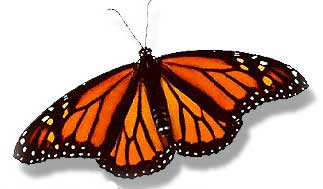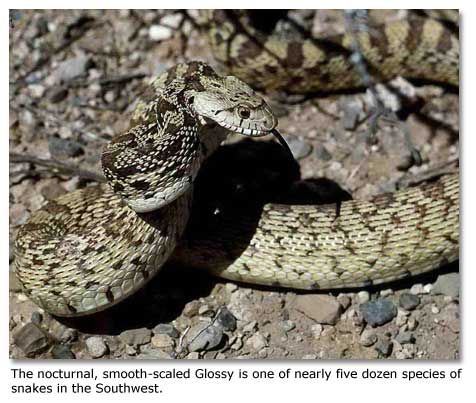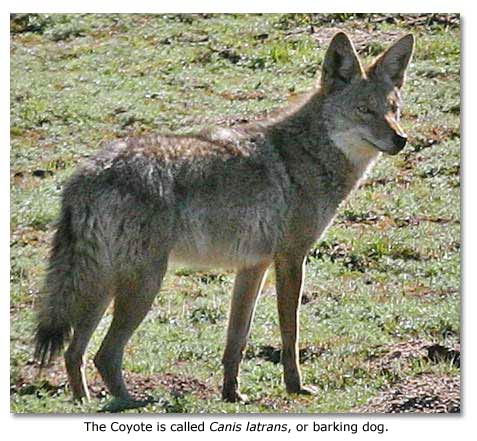How Many Basic Animal Classes Are There

How Are Animals Classified?
By Jay W. Abrupt
[How Are Plants Classified?]
Biological scientists estimate that collectively the earth's 5 to 40 million species of organisms (depending on the estimate you cull to believe) make up a full of some ii trillion tons of living matter, or biomass. The plants comprise well over 90 percent of the biomass. The animals, the focus of this article, comprise just a small percentage of the biomass, merely they business relationship for the majority of species.

In accordance with the Linnaeus method, scientists classify the animals, as they do the plants, on the basis of shared concrete characteristics. They place them in a hierarchy of groupings, beginning with the kingdom animalia and proceeding through phyla, classes, orders, families, genera and species. The animal kingdom, similar to the establish kingdom, comprises groups of phyla; a phylum (singular for phyla) includes groups of classes; a form, groups of orders; an order, groups of families; a family, groups of genera; and a genus (singular of genera), groups of species. As established by Linnaeus, the scientists call an animal species, as they do a found species, by the proper noun of the genus, capitalized, and the species, uncapitalized. Then far, the scientists have classified and named something over a million animate being species. Without uncertainty, they take millions more to go.
Taxonomists, biological scientists who specialize in classifying and naming the living organisms, group the multicellular, independently mobile organisms that eat other organisms into the kingdom of animalia. The taxonomists recognize that the animals, unlike the plants, possess specialized tissues that may be organized into even more specialized organs, and they recognize that nearly animals, especially the more evolutionarily avant-garde species, accept "bilateral symmetry," which means that the correct and left sides are essentially mirror images of each other. Critically, specially in the desert, animals, unlike plants, often utilize their mobility to seek refuge from environmental stresses such as intense rut and prolonged drought.
Beast Populations
Worldwide, the animal population consists of species numbering somewhere in the millions. The largest, the blue whale, may exceed 100 feet in length and 150 tons in weight. The smallest known animals, for example, a parasitic wasp that taxonomists take named Dicopomorpha echmepterygis, measure no more than than a few thousands of an inch in length.
The most abundant and diverse creature communities occupy globe's most biologically productive regions, for example, the tropical rainforests, where the species of living organisms probably number in the millions. Conversely, the to the lowest degree abundant and diverse creature communities live in the least biologically productive regions, in item, deserts like those of our Southwest, where the species of living organisms probable number in the tens to hundreds of thousands.
The biological richness of a tropical rainforest contrasts sharply with the biological impoverishment of our deserts. The net biological productivity of a typical area in a tropical rainforest may exceed that of a comparable area in our desert lands by a factor of 40 to 50 times, according to the Physical Geography.net Internet site. Moreover, according to the Tropical Rainforest Biome Internet site, "Scientists believe that the tropical rainforests of the world might concord up to ninety pct of the plant and animal species on world." In a paper called "Tropical Biomes," Professor Ralph Due east. Taggart, Michigan Country University, said "The total biological diversity of only a few square kilometers of rich tropical rainforest can exceed that of entire regions in the temperate zone. Virtually of the plants and animals of the world are found in the complex mosaic of natural communities that brand up this biome." Nevertheless, our deserts host a various and highly adjusted community of animals.

The Beast Community
Taxonomists typically split up the beast kingdom into ii "subkingdoms," which include the invertebrates (animals without backbones) and vertebrates (animals with backbones). As with the plants, taxonomists plow the subsequent animal groupings and classifications, from phyla through genera, into a churning landscape that is merely a role of the scientific process. Depending on their academic roots and research, they divide and re-divide the animal customs in many different ways, frequently regrouping, reclassifying and even re-naming species as they go. Some, called "lumpers," identify species as belonging to the aforementioned group even though in that location may be small differences. Other scientists, called "splitters," identify the same species equally belonging in distinct groups because of the same minor differences. The lumpers produce a relatively simple taxonomy, the splitters, a far more complex taxonomy.

Classifying an Invertebrate
In our deserts, the invertebrate subkingdom includes phyla such as arthropods (insects, centipedes, spiders, scorpions, desert shrimp and many others), mollusks (snails) and annelids (earthworms). In the desert, as well as across the world, arthropods, measured in terms of abundance and diversity, rank at the meridian of all the beast phyla. An elegant insect, the monarch butterfly, serves as example of how the classification system works for the invertebrates.
At the phylum level, the monarch belongs to the arthropods, which share several concrete characteristics. According to Barbara Terkanian, "A Vertebrate Looks At Arthropods," A Natural History of the Sonoran Desert, the arthropods have jointed legs, and they have external skeletons, or exoskeletal material, that includes "eyes, mouthparts, antennae, body, legs, the fore and hind sections of the digestive tract, and some respiratory surfaces. Regions of flexible, unhardened exoskeleton serve as joints between neighboring segments." The body cavity contains the digestive, circulatory, nervous and reproductive systems.

At the form level, the monarch has membership in the insect group, which comprises the overwhelming majority of the arthropods. The insects have several distinguishing concrete characteristics, including iii-role bodies, half dozen legs (three pairs), compound optics and two antennae. The class, called Insecta, includes iii subclasses, according to Kendall Bioresearch Services Internet site. The get-go consists of insects that have never had wings throughout their evolutionary history. The young resemble the adults. The second subclass consists of insects that have wings at present or had them at some bespeak during their evolutionary history. The nymphs resemble the adults. The third subclass consists of insects that have wings now or had them at some point during their evolutionary history. The young take the course of larvae that change into adults during a non-feeding metamorphosis. The first subclass consists of four orders, including, for example, bristletails and springs tails. The second subclass has 16 orders, including, for case, dragonflies; crickets, grasshoppers and locusts; termites and sucking lice. The tertiary subclass has nine orders, comprising insects such as beetles; fleas; bees, wasps and ants; and the butterflies and moths.
At the order level, the monarch belongs to collywobbles and moths, called Lepidoptera, which rank high among the most intriguing and conspicuous insect orders in the Southwest. They have two pairs of bleary, scaled and often brightly colored wings. Typically they take big eyes, long antennae and a long sucking tube (which the insect coils below its head when not feeding). The larvae, or caterpillars, all have silk glands that they use for spinning their cocoons. Their order contains well over 100 families.
At the family level, the monarch is the star of the milkweed collywobbles, called Danaidae, which are among the best known in our deserts (besides as across the state). The milkweed butterflies usually have goldish wings trimmed in black, according to Donald J. Borror and Richard E. White, A Field Guide to the Insects of America North of Mexico. Their caterpillars feed on milkweed leaves, which invest both larvae and adults with a bitter and toxic taste that discourages predators.
At the genera level, the monarch is i of a mere handful of closely related species collectively chosen Dannaus. These species show patently common evolutionary origins in their caterpillars, which share similar spots and polish skin texture on their abdomens, according to David Munro, "The Biogeography of the monarch Butterfly," San Francisco Land Academy, Department of Geology, autumn 1999.
At the species level, the monarch is called plexippus. Information technology is, says Munro, "a medium sized butterfly, measuring about 3 inches from wingtip to wingtip. Its body is virtually one inch long. Its 4 wings are generally a field of yellow, orange or gold, with veins of blackness running through them. A ring of black, thickest at the forepart, rings the wings, and the torso is black too. This blackness band is unremarkably speckled with white spots, larger at the front and smaller at the back."
The monarch, the blueblood of the butterfly and moth world, bears the scientific name of Dannaus plexippus. In summary, it fits into the Linnaeus classification scheme as follows:
| Classification Level | Scientific Proper noun |
| Kingdom | Animalia |
| Subkingdom | Invertebrate |
| Phylum | Arthropoda |
| Form | Insecta |
| Society | Lepidoptera |
| Family unit | Danaidae |
| Genus | Dannaus |
| Species | Plexippus |
| Common Name | Monarch Butterfly |
| Scientific Name | Dannaus plexippus |
In one of the most compelling of nature's mysteries, the monarchs, which have a nationwide distribution, begin annual epic migrations by the millions during the autumn. Those from our Southwestern states to the Northwest migrate to southern California. Those from the Midwest to the eastern seaboard drift across the southern Chihuahuan Desert to the mountains of central Mexico, covering thousands of miles. Their journeying is closely watched along the unabridged route. Their arrival in Mexico calls for celebration: "The collywobbles take arrived in Saltillo (in the southeastern corner of the Chihuahuan Desert)!" 1 Mexican woman reported to the Monarch Butterfly Internet site in 1999. "Since early this morn (Oct 12), nosotros have welcomed the inflow of the monarchs throughout the metropolis, there accept been hundreds of monarchs gliding through from 3 to 50 meters in top"

Classifying a Vertebrate
The vertebrate subkingdom of our deserts includes phyla comprising a surprisingly diverseness of mammals, birds, reptiles, amphibians and fifty-fifty fish.
"The Southwest contributes impressively to the continentwide multifariousness of mammals; native mammal species in southwestern states number most 120 in Texas, 138 in Arizona, 139 in New United mexican states, and 163 in California. No other region in the country has so many mammal species," says the United States Geological Survey in its Science for a Irresolute Earth Internet site.

The Southwest contributes even more than to the diverseness of birds. Southeastern Arizona's Chiricahua Mountains bird "checklist presently stands at 375 species [including the splendid Elegant Trogon], non including 18 species still considered hypothetical—about one-half of all the birds regular occurring on this continent northward of Mexico," according to Richard C. Taylor'south Location Checklist to the Birds of the Chiricahua Mountains. Central New Mexico'south Bosque del Apache'south checklist "contains 377 species which have been observed on the refuge since 1940," according to the USGS Bird Checklists of the United States.
As for reptiles and amphibians, more than than 150 species "occur in the Southwest; this is partly due to the region'southward various habitats," says the USGS in Science for a Changing World. "Compared with the moister habitats of eastern North America, the southwestern amphibian fauna is relatively poor, with merely 3 salamander species and most 30 frog and toad species. About 25% of the amphibians, though, are found nowhere else in the United States. About 50 cadger and 56 snake species business relationship for more than 70% of the reptiles and amphibians inhabiting this region; most of these live in the arid and semiarid desert grasslands and shrublands that make upwardly about of the Southwest."

The Southwest'due south few h2o sources host a surprising multifariousness of fish, although many of the species are imperiled by human attack on their habitat. According to the USGS, the Colorado River drainage arrangement is habitation to numerous species including diverse chubs, the Colorado squawfish, the razorback sucker and the bonytail. The Rio Grande system of the Colorado River drainage arrangement is home to chubs, the silvery minnow and shiners. Desert springs serve as habitat for pupfishes, springfishes and poolfishes.
An icon of the Southwest, the coyote, serves as a guide to how the classification system works for the vertebrates.

At the phylum level, the coyote belongs to the Chordata, which is distinguished by a nerve chord that passes through the backbone. At the class level, the animal belongs to the Mammalia, the members of which possess fur and nurse their immature. At the gild level, the coyote, like his fellow Carnivora, shares "extreme night vision capabilities and various more than broadly defined characteristics including: loftier intelligence, relatively long maturation catamenia for the immature, dental similarities, tendency for complex social organization, and generally bearing 2-3 immature in a litter (but they may birth as many as 4-5 at one time)," according to the Tigerhomes.org Internet site. At the family level, our guide and his shut relatives, collectively called Canidae, typically have elongated faces. They have like tooth arrangements, or "dental formulas." Different, say, a comport, which belongs to another family unit of mammals, the Canidae walk on their toes. At the genus level, the coyote and the related species – including the greyness wolf (northern Chihuahuan Desert and the Colorado Plateau), the blood-red wolf (western Piney Woods) and your family dog – belong to the Canis. They all deport wolf-like characteristics, and they can interbreed, provided the male person and female person are of compatible size. (A male person chihuahua would experience a difficult time mating with a female person grayness wolf.)
At the species level, the coyote is called Canis latrans, or barking dog, an allusion to the animal'due south vocal talents. Information technology is about the size and shape of "a medium-sized Collie canis familiaris, but its tail is circular and bushy and is carried straight out below the level of its dorsum," according to 'southward commodity on the brute. "Coyotes institute in depression deserts and valleys weigh well-nigh 20 pounds, less than one-half of their mountain kin, who can weigh up to 50 pounds. Desert coyotes are light gray or tan with a black tip on the tail." William H. Burt and Richard P. Grossenheider bespeak out in their A Field Guide to the Mammals of America North of Mexico, the coyote'southward nose "is more pointed and [the] tail is bushier than normal in dogs; [its tail is] held down between [its] hind legs when running." In summary, it fits into the Linnaeus classification scheme as follows:
| Nomenclature Level | Scientific Proper noun |
| Kingdom | Animalia |
| Subkingdom | Vertebrate |
| Phylum | Chordata |
| Form | Mammalia |
| Order | Carnivora |
| Family unit | Canidae |
| Genus | Canis |
| Species | Latrans |
| Common Name | Coyote |
| Scientific Name | Canis latrans |
The coyote has long played a fundamental part in the folk tales, myths and persona of the peoples of the Southwestern deserts, often taking on the office of clown or charlatan. In stories recorded by Charles F. Lummis in his Pueblo Indian Folk-Stories, foolish coyote falls for practical jokes played by ravens, blackbirds and a carry. Empathetic coyote saves an abandoned infant, bestowing it upon a mother antelope that has lost her fawn. Magical coyote jumps through a willow hoop and emerges as a handsome young man.
While fellow Canis Mexican grayness wolf disappeared (until existence reintroduced) from the Southwestern deserts in historic times, clever, adaptable and bold coyote has increased its population and expanded its range from its native desert basins well up into the mountains.
Thief coyote can make a nuisance of himself. "Nosotros always had a big watermelon patch," said J. Frank Dobie in Some Office of Myself. "It had to be big if we were going to take any melons ourselves after the coyotes took their pct. The patch was in a valley field merely a few hundred yards abroad from the house. At nighttime we could hear the coyotes laughing over how juicy the watermelons were."
Related Pages:
How Are Plants Classified?/flora/establish-classified.html
Desert Animals & Wild animals
Desert Food Concatenation
Desert Institute and Wildflowers
Share this page on Facebook:
DesertUSA Newsletter -- Nosotros ship articles on hiking, camping and places to explore, as well as animals, wildflower reports, establish information and much more. Sign upwardly below or read more about the DesertUSA newsletter here. (Information technology's Free.)
The Desert Environment
The N American Deserts
Desert Geological Terms
Source: https://www.desertusa.com/desert-activity/classified-plants-animals.html
Posted by: sampsonthemposs.blogspot.com

0 Response to "How Many Basic Animal Classes Are There"
Post a Comment